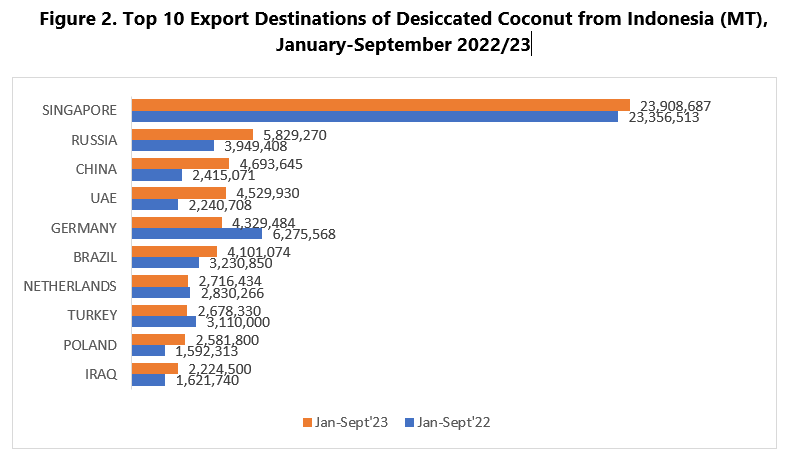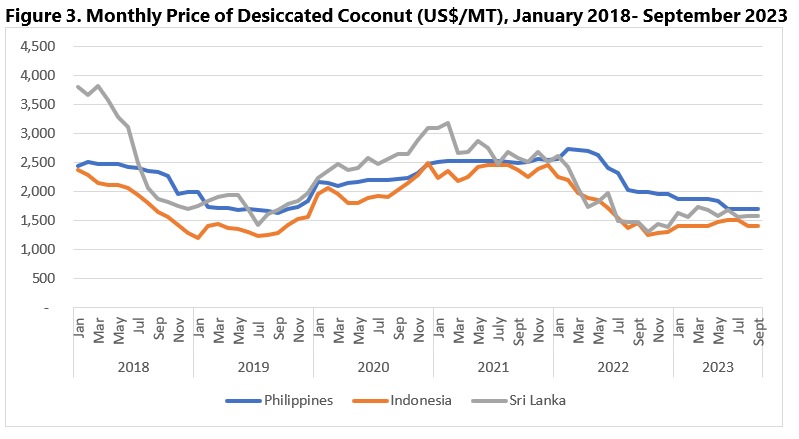- Home
- Statistics
- Market Review
Market Review of Dessicated Coconut
October 2023
The global demand for desiccated coconut has seen a substantial surge, with the Philippines and Indonesia emerging as pivotal contributors to the production and export of this commodity.
The Philippines exhibited a consistent growth trajectory in desiccated coconut exports over recent years. In 2019, the country exported 147,594 metric tons, which experienced a slight dip to 145,200 metric tons in 2020. However, it rebounded to 160,117 metric tons in 2021 and maintained a steady figure of 156,930 tons in 2022. Nonetheless, the most recent data from the Philippine Statistics Authority for the first half of 2023 indicates a downward trend, with export volumes dropping to 74,640 metric tons, representing a 13% decline compared to the same period the previous year.

Top export destinations for Philippine desiccated coconut during January-June 2023 included the United States of America and the Netherlands, importing 23,369 metric tons and 18,947 metric tons, respectively. Other significant destinations comprised Turkey, Australia, Canada, China, and the United Kingdom, each importing over 2,000 metric tons. This data underscores the robust demand for desiccated coconut across North America, Europe, and Asia.
In the case of Indonesia, desiccated coconut exports experienced a decline in 2019 but have since rebounded. In 2018, Indonesia exported 109,181 metric tons, which decreased to 98,742 metric tons in 2019 but then increased to 128,087 metric tons in 2020. The upward trend continued in 2021, reaching 139,932 metric tons, but declined to 110,455 metric tons in 2022. However, as of the third quarter of 2023, Indonesia's export volume stood at 83,796 metric tons, surpassing the 2022 volume of 82,796 tons.

Indonesia's primary export markets for desiccated coconut are the European Union (EU27), followed by Singapore and the Russian Federation. China, the UAE, and Germany also represent significant importers.
The global demand for desiccated coconut in 2023 is projected to decline, continuing the trend observed in 2021 and 2022. Notably, there has been a significant decrease in global imports of desiccated coconut from 2021 to 2022, with a decline of 29.7%, primarily driven by diminishing demand in European countries. The declining trend in 2023 is chiefly influenced by weakening demand in European countries and the United States of America, with import volumes in the EU27 expected to drop by 20%, and US imports forecasted to decrease by 22%. Over the past decade, both the EU27 and the US have shown a slight decrease in demand for desiccated coconut, with compound annual growth rates (CAGR) of -1% and -2.3%, respectively.

The prices of desiccated coconut exhibited a declining trend throughout 2023 in the Philippines, Indonesia, and Sri Lanka. Until the third quarter of 2023, the average price of desiccated coconut in the Philippines was US$1,787/MT, representing a 27% decrease compared to the same period in 2022. Similarly, average prices of desiccated coconut in Indonesia and Sri Lanka showed a declining trend, with average monthly prices of US$1,431/MT and US$1,614/MT, respectively, reflecting decreases of 21% and 14%.

One potential contributing factor to the declining prices is the observed high inflation rate in several European countries and the US, which may have diminished consumer purchasing power, subsequently dampening demand for coconut products, including desiccated coconut. Additionally, an anticipated economic slowdown in the near future could further impact demand and prices in this market.
